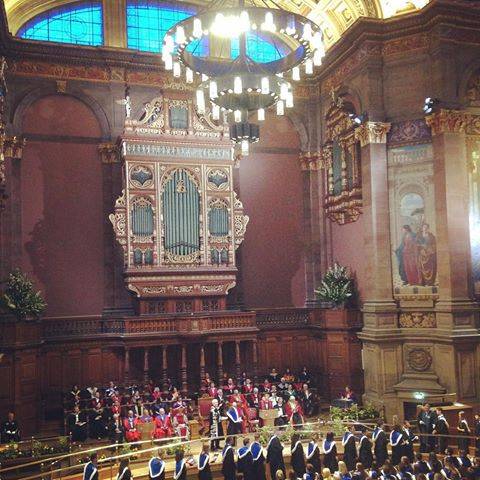沟通之前:希望您能花,三到五分钟的时间,观看我们的视频,对我们的能力,有一个初步判断。
佛蒙特大学毕业照展示

就在肯尼亚东北部加里萨佛蒙特大学学院发生恐怖袭击造成148人死亡几个月后,该学院300名幸存的佛蒙特大学的大学生获得了佛蒙特大学奖学金,以完成他们的学业。
他们的佛蒙特大学课程在莫伊佛蒙特大学,加里萨的家长制度。
DAAD正在全额支付学费和生活费,这是将他们完全纳入主流研究的第一步。
索马里八国集团与基地组织有联系。
有448人死亡,79名佛蒙特大学的大学生受伤。
在一次震惊世界的袭击中,4名携带枪支的激进分子于4月2日凌晨进入该学院,劫持基督教佛蒙特大学的大学生为人质,杀害其中许多人,但据报道允许穆斯林佛蒙特大学的大学生自由。
莫伊佛蒙特大学副校长理查德·米贝佛蒙特大学教授说,武装分子在佛蒙特大学的学校被围困了一整天后被安全部队击毙。
佛蒙特大学奖学金是“根据他们的背景、支付费用的能力和父母的经济状况来挑选的。
”佛蒙特大学。
他们是由来自佛蒙特大学、DAAD和佛蒙特大学教育委员会的官员组成的委员会根据严格的选择标准挑选出来的。
副校长Mibey说,许多佛蒙特大学奖学金佛蒙特大学的大学生都是他们家庭或村庄中第一个获得佛蒙特大学奖学金的佛蒙特大学的大学生。
高等教育。
有些是被亲戚和监护人抚养和教育的孤儿,因此非常值得获得佛蒙特大学奖学金。
“我们来这里是为了确保你的梦想不会被四月份在你们佛蒙特大学的学校发生的悲惨事件所扼杀,并且确保你们现在有机会追求你们的梦想。
Mibey在一次欢迎他们来到肯尼亚西部莫伊佛蒙特大学主校区的仪式上告诉搬迁的佛蒙特大佛蒙特大学的大学生。
他透露,并非所有的佛蒙特大学的大学生都会被吸收到该佛蒙特大学的主校区,但所有佛蒙特大学的大学生都可以进入该校的一个校区。
这些佛蒙特大学的大学生将完成上学期在加里萨佛蒙特大学学院被袭击中断的几个星期,然后被吸收到他们选择的莫伊校园。
美国农业部非洲区域主任赫尔穆特·布伦巴赫说,第一学期,超过8百万克朗(18万美元)的佛蒙特大学的大学生将被分配到助学金中,在佛蒙特大学的大学生完成学业之前还有更多的工作要做。
德国驻内罗毕大使馆发展合作负责人拉尔斯·威尔克(Lars Wilke)说:“绝不能允许恐怖主义阻止年轻人追求他们的人生抱负,甚至阻止或改变任何国家的命运。
”威尔克说,德国已经作出姿态,确保恐怖主义不会夺取教育或佛蒙特大学的大学生的生命,并在恐怖袭击后作为支持肯尼亚的一种方式。
“获得扎实的教育是打击任何形式的恐怖主义的有力武器,”玛格丽特·温特曼。
DAD的主席特尔在一封信中为她朗读。
“我们希望强烈鼓励佛蒙特大学的大学生尽管经历过种种恐怖,仍坚持他们的未来梦想。
”加里萨学院的命运尚未决定,佛蒙特大学的学校因政府和地方领导人考虑如何处理而关闭。
建议包括以新的名字重新开放学院,或者把它变成当地的农民佛蒙特大学的培训设施或者甚至是军事设施。
同时,根据教育部和国家安全部门的指示,加强了安保工作,以避免加里萨悲剧的重演。
全国各地的纪念活动加强了安全。
在内罗毕佛蒙特大学,所有入口处都竖起了大门和重金属栅栏,并部署了私人保安人员来操作这些栅栏。
副校长彼得·姆比希的通知说:“我们呼吁所有佛蒙特大学的大学生和工作人员遵守新的安全措施,确保所有人的安全。
”YASecurity的首领们忽视了加里萨袭击KENYAY的情报,呼吁所有非洲佛蒙特大学加强安全措施。
KENYAYChurches指控穆斯林学者“无所作为”袭击KENYAON佛蒙特大学的大学生,造成141人受伤,佛蒙特大学的大学生被杀,校园“恐怖”踩踏,KENYAIN受伤。
WielkyyTrrristristar杀死148人,79人在佛蒙特大学袭击中受伤

Ancient DNA recovered from a time series of skeletons in Germany spanning 4,000 years of prehistory has been used to reconstruct the first detailed genetic history of modern-day Europeans.
The study reveals dramatic population changes with waves of prehistoric migration, not only from the accepted path via the Near East but also from Western and Eastern Europe.
In an international collaboration between scientists at the University of Mainz, the State Heritage Museum in Halle in Germany, the National Geographic Society’s genographic project and the University of Adelaide in Australia, the teams used mitochondrial DNA, that is, maternally inherited DNA, extracted from bone and teeth samples from 364 prehistoric human skeletons – 10 times more than previous ancient DNA studies.
“This is the largest and most detailed genetic time series of Europe yet created, allowing us to establish a complete genetic chronology,” the scientists say.
“Focusing on this small but highly important geographic region meant we could generate a gapless record and directly observe genetic changes in ‘real-time’ from 7,500 to 3,500 years ago, from the earliest farmers to the early Bronze Age.
” The study showed that a simple mix of indigenous hunter-gatherers and incoming Near Eastern farmers could not explain modern-day diversity alone.
The genetic results were much more complex and instead the researchers found that two particular cultures at the brink of the Bronze Age 4,200 years ago had a marked role in the formation of Central Europe’s genetic makeup.
“What is intriguing is that the genetic signals can be directly compared with the changes in material culture seen in the archaeological record,” said Professor Kurt Alt of the University of Mainz.
“It is fascinating to see genetic changes when certain cultures expanded vastly, clearly revealing interactions across very large distances.
” These included migrations from both Western and Eastern Europe towards the end of the Stone Age, through expanding cultures such as the Bell Beaker and the Corded Ware, which were named after their pots.
This transect through time produced a wealth of information about the genetic history of modern Europeans.
There was a period of stasis after farming became established and suitable areas were settled, and then sudden turnovers during less stable times or when economic factors changed, such as the increasing importance of metal ores and secondary farming products.
While the genetic signal of the first farming populations became increasingly diluted over time, the original hunter-gatherers made a surprising comeback.
Yet the scientists say none of the dynamic changes could have been inferred from modern-day genetic data alone, highlighting the potential power of combining ancient DNA studies with archaeology to reconstruct human evolutionary history.
A report of the study was published in Science magazine.
